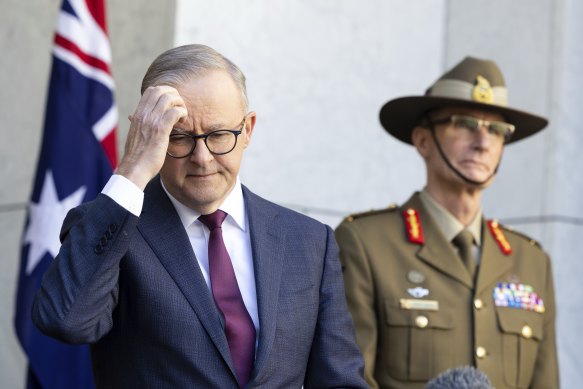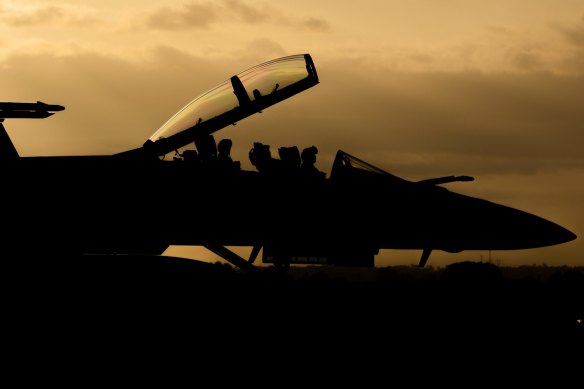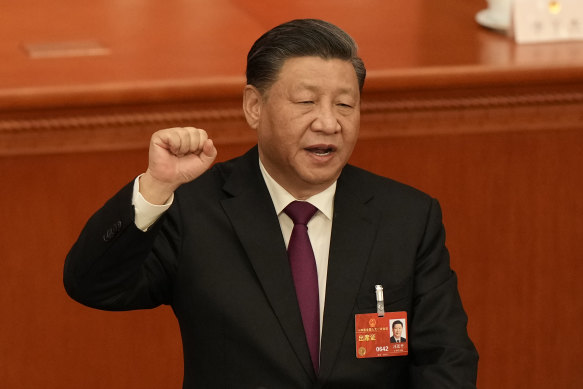Defence review’s a good beginning, but lacks a middle and an end

Save articles for later
Add articles to your saved list and come back to them any time.
In the past year or so, Australia has produced two major defence plans. In the same time, China has produced two submarines. While Australia plans, China deploys.
This helps explain why the Albanese government’s new defence strategic review puts a high priority on urgency. The review released yesterday finds that “the risks we face are profound”. And that Australia’s military “is not fully fit for purpose”. The government agrees.
Prime Minister Anthony Albanese and Chief of the Australian Defence Force Angus Campbell during a press conference at Parliament House in Canberra on Monday.Credit: Alex Ellinghausen
The review makes an “urgent call to action”. The government agrees, again. “There’s no time to lose,” adds Defence Minister Richard Marles.
The report repeats a three-year-old alarm first sounded by the Morrison government – that Australia can no longer assume that it will have a ten-year warning of attack by a hostile power.
“Instead of a 10-year warning time, the review has identified three distinct time periods for defence planning,” which it nominates as the next three years, the five years following and the period 2031 and beyond.
Mysteriously, it offers no explanation of the meaning of these deadlines. The classified version of the report would be more explicit, presumably.
Australia spends US$32 billion annually on defence. China spends US$292 billion.Credit: Asanka Ratnayake/Getty Images
The review, led by former Labor defence minister Stephen Smith and former chief of the Defence Force Angus Houston, makes a good start by bluntly naming the problem. Part one: “The US is no longer the unipolar leader of the Indo-Pacific.”
Part two: “China’s military build-up is now the largest and most ambitious of any country since the end of the Second World War. This build-up is occurring without transparency or reassurance to the Indo-Pacific region of China’s strategic intent.” So America is weaker and China stronger, in sum.
Coincidentally, the Stockholm International Peace Research Institute published its annual study of worldwide military spending yesterday. The US remained overwhelmingly the biggest spender with $US877 billion in outlays last year, boosted by about $20 billion in aid to Ukraine.
Second was China with $US292 billion, a SIPRI estimate because China’s disclosures are opaque. “This was 4.2 per cent more than in 2021 and 63 per cent more than in 2013,” reports SIPRI. “China’s military expenditure has increased for 28 consecutive years.”
Chinese President Xi Jinping. Prime Minister Anthony Albanese says: “China’s assertion of sovereignty over the South China Sea threatens the global rules-based order in the Indo-Pacific.”Credit: AP
Anthony Albanese’s defence strategic review continues: “China’s assertion of sovereignty over the South China Sea threatens the global rules-based order in the Indo-Pacific in a way that adversely impacts Australia’s national interests. China is also engaged in strategic competition in Australia’s near neighbourhood.”
So what, sceptics will ask? Beijing isn’t going to order an invasion, is it? The review addresses this question: “While there is at present only a remote possibility of any power contemplating an invasion of our continent, the threat of the use of military force or coercion against Australia does not require invasion.
“More countries are able to project combat power across greater ranges, including against our trade and supply routes, which are vital for Australia’s economic prosperity.” In other words, exactly what Japan planned to do in the 1940s, to cut Australia off.
If this is the problem, what’s the solution? “For the first time in 80 years, we must go back to fundamentals, to take a first-principles approach as to how we manage and seek to avoid the highest level of strategic risk we now face as a nation: the prospect of major conflict that directly threatens our national interest.”
This rare forthrightness in an official document is useful. But, so far, all of this information has been common public knowledge for years; any first-year university student of international security could have drawn these conclusions.
The review prescribes some solutions. It starts with some big concepts. In essence, the reviewers conclude that the defence forces alone are not enough to defend Australia.
They call for a “whole of government” and even a “whole of nation” approach harnessing “all elements of national power”. This is starting to approach the level of a national mobilisation.
“Whole of government” requires active statecraft in the region, which the government agrees should be led by a better-funded Department of Foreign Affairs and Trade. But onshore, it demands “harmonisation” of policy on trade and investment, education, minerals and resources, clean energy, climate, industry and infrastructure “and more”.
And “whole of nation” strategy, according to the review, will demand close co-operation with the private sector in a way Australian governments haven’t done outside wartime.
For example, the domestic fuel industry would need to work closely with the government to ensure supply, and offshore oil and gas drilling platforms could be required for military deployments and operations. The government’s response to these “whole of nation” recommendations? “Agreed,” it states, without elaboration.
As for the defence forces, the review reinforces some existing priorities. The AUKUS submarines and high-tech development plans are endorsed.
The reviewers and the government agree fervently on the urgent need for long-range missiles to “hold an adversary at risk at greater distances”. Marles calls this “impactful projection”, which, in English, means blowing up enemy craft before they can cut off Australia’s trade routes or occupy Pacific islands.
The government has committed to buying US long-range missiles in the short run and setting up manufacturing plants to make some of our own in the longer run. The upcoming federal budget will include some specifics.
This is unsurprising. Morrison had set out the same intentions. What is surprising to the average taxpayer is that Australia has no long-range strike weapons at the moment, despite $48 billion in annual defence budgets.
The other surprise is that the review urges the government to commit more money to defence, but that the government says it will keep the defence budget broadly unchanged overall, at least for the next few years.
How? By cancelling redundant programs. It’s named a couple already, but it will need to find much bigger programs to cut. Which ones? Wait for it – the government promises two more reviews over the next 12 months to answer these questions. This review is a good beginning, but lacks a middle and an end.
If future wars are conducted by reviews, Australia will be competitive.
The Opinion newsletter is a weekly wrap of views that will challenge, champion and inform your own. Sign up here.
Most Viewed in Politics
From our partners
Source: Read Full Article


